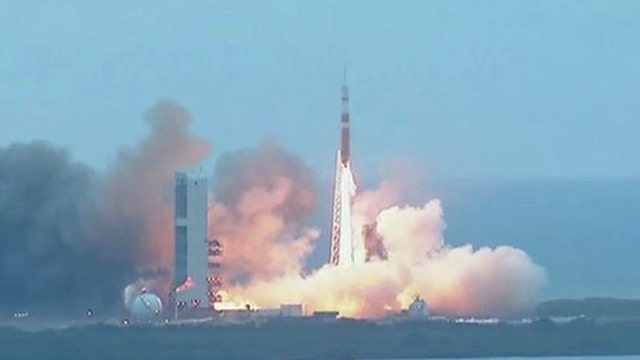NASA's Orion spacecraft blasts off in historic test flight
'New era in American space exploration' as rocket is launched from Cape Canaveral, Florida
After scrubbing the initial launch on Thursday, NASA’s new Orion spacecraft made its inaugural test flight on Friday, lifting off from Cape Canaveral, Fla., at 7:05 a.m. ET.
Friday’s 4 hour and 23 minute orbital mission will take Orion deeper into space than any spacecraft built for humans has traveled in more than 40 years.
The unmanned flight, dubbed Exploration Flight Test-1, will provide NASA with vital information on the spacecraft’s performance. NASA plans to eventually use Orion on ambitious manned missions to Mars and an asteroid.
The launch was pushed back from Thursday after a series of delays and technical glitches, with NASA engineers focusing their attention on the ‘fill-and-drain’ valves on the Delta IV Heavy Rocket that carries Orion on the first stage of its journey. In a blog post, NASA explained that liquid nitrogen valves failed to close properly late in Thursday’s countdown to launch. During normal operation the valves stay open during fueling and shut tight a few minutes before liftoff to seal the fuel tank.
The Delta IV rockets performed well during Friday's launch. "It was an awesome job, an awesome job by the Delta IV team," said Mark Geyer, NASA's Orion program manager, shortly after liftoff.
The launch comes at a crucial time for U.S. spaceflight, which has recently suffered some high-profile setbacks. On Oct. 28 an unmanned Antares rocket exploded in a fireball shortly after liftoff from a NASA launchpad in Wallops Island, Virginia. Just three days later Virgin Galactic's SpaceShipTwo space tourism rocket crashed during a test flight over the Mojave Desert, killing one of the two pilots aboard and seriously injuring the other.
During Friday’s test flight, Orion will orbit earth twice, covering more than 60,000 miles and reaching an altitude of 3,600 miles, almost 14 times beyond the International Space Station’s orbit. Orion is expected to reach its peak altitude 3 hours and 5 minutes into its flight.
The successor to the now-retired Space Shuttles is expected to reach a speed of 20,000 mph on its return through the earth’s atmosphere, generating temperatures around 4,000 degrees on the spacecraft’s heat shield. The 16.5-foot heat shield has been described by NASA as the largest and most advanced of its kind.
The mission will also provide a crucial test of Orion’s avionics and control systems, as well as the parachutes that will deploy on its return to earth. Orion is rigged with 1,200 sensors to gauge its durability for the day when astronauts climb aboard during the decade ahead.
Eventually Orion will carry a crew of four astronauts to deep space destinations, which include an asteroid to be corralled in lunar orbit for human exploration in the 2020s, followed by Mars in the 2030s.
Orion’s crew module is expected to splashdown in the Pacific Ocean about 600 miles off the coast of Baja California, where it will be retrieved by a joint NASA and U.S. Navy team. Orion will be brought back to the U.S. on board the USS Anchorage.
The $370 million test flight is being managed by NASA contractor Lockheed Martin. The Delta IV Heavy Rocket was built by United Launch Alliance.
Future Orion launches will use the mega rocket still under development by NASA, known as SLS or Space Launch System. The first Orion-SLS launch is targeted for 2018, unmanned, followed by the first piloted mission in 2021.
The Associated Press contributed to this report.
Follow James Rogers on Twitter @jamesjrogers









































